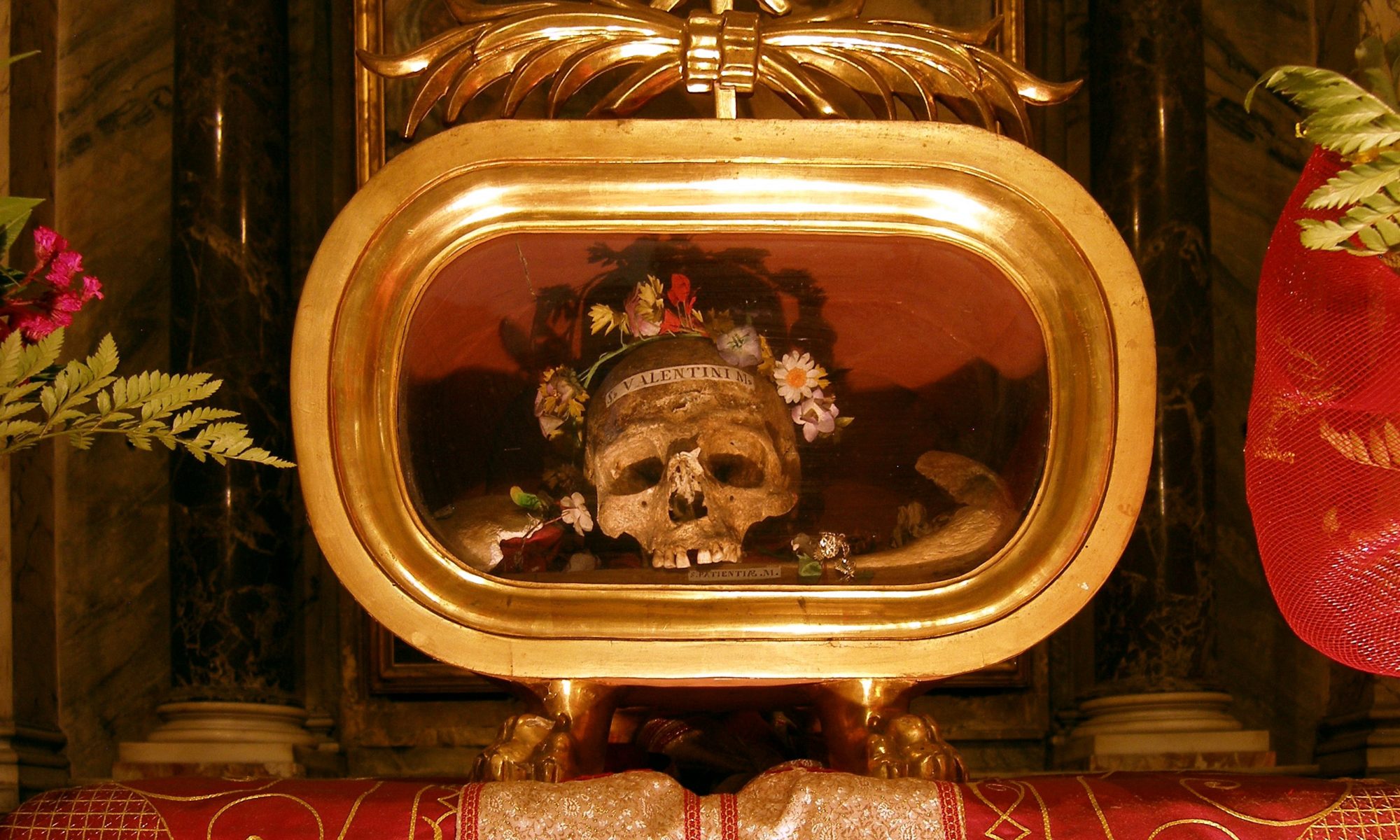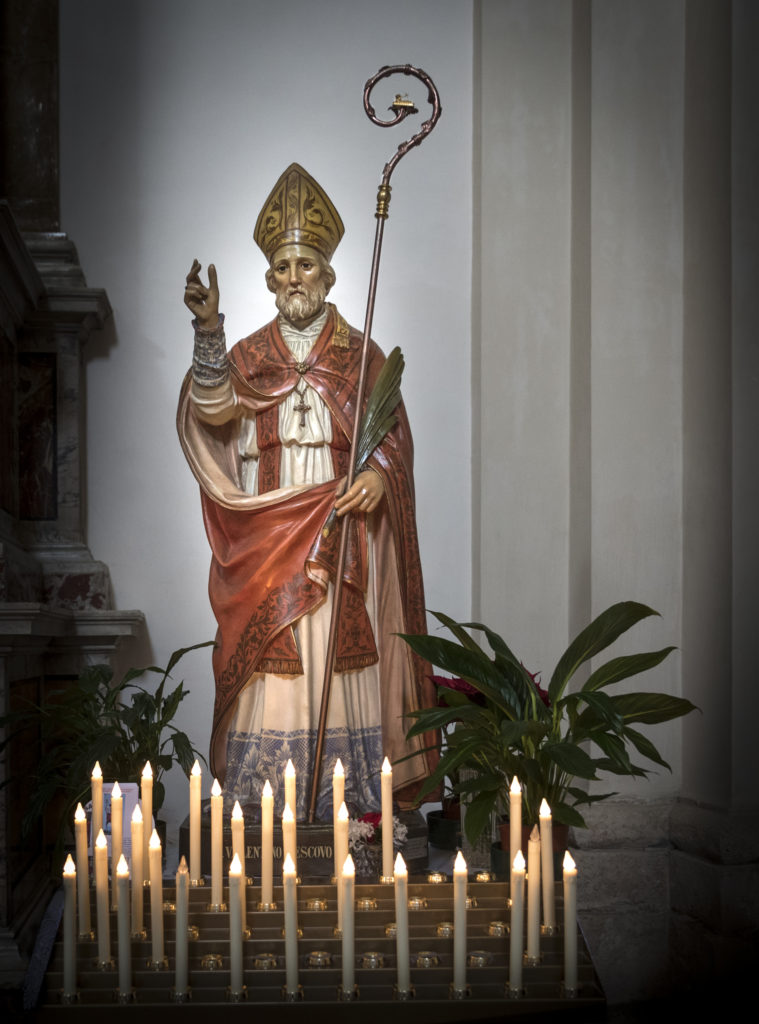February 14 is the feast day of Saint Valentine, a day observed all over the world as a celebration of love and lovers. But who was St. Valentine, and how did he become the patron saint of lovers?
The Origin of St. Valentine’s Day
The story of how February 14 became St. Valentine’s Day is pretty clear. However, the story of how St. Valentine’s Day became the day of love is not so clear.
In the Catholic Church, certain people who have lived exemplary or heroic lives as devout Christians are posthumously canonized as saints. Just as a living person is honored each year on his or her birthday, a saint is honored each year on a particular day, known as that saint’s feast day. A saint’s feast day is usually the day of his or her death. In the case of St. Valentine, he was martyred for his Christian faith, in Rome, during the reign of Emperor Claudius II (A.D. 268–270). His martyrdom is believed to have taken place on the 14th of February; therefore, that is his feast day. [2]
Who was St. Valentine?
There are several stories about a saint named Valentine. Maybe all of the stories are referring to the same person; or, maybe there were two or more different saints of the same name, and each story is about one of them. In the early days of Christianity, when there were many martyrs, it was customary for a new martyr to be honored on the same day as an older martyr of the same name. Therefore, we cannot rule out the possibility that several people named Valentine were martyred at different times, and all celebrated on the same day. In that case, the story of one St. Valentine could easily get confused with the story of another.
One of the most commonly told stories of St. Valentine states that he was a priest in 3rd-century Rome. The Roman Emperor, Claudius II, had (according to the story) strictly forbidden soldiers to marry. (Celibacy was considered superior for soldiers, and military service was mandatory for single men.) St. Valentine was reportedly put to death for performing Christian weddings for young soldiers in Rome. (Not only were the weddings illegal, but Christianity itself was, of course, banned in the Roman Empire at that time.) [1]
Historians’ Opinion
Historians doubt that the above story is true. For one thing, the ban on military weddings, instituted under the Emperor Augustus, had already been repealed by the time Claudius II was Emperor.
Also, Valentine is said to have been from Terni, Italy. Yet he was martyred in Rome. Are St. Valentine of Terni and St. Valentine of Rome two different people? Or are they the same person, who traveled from one city to the other? Nobody knows. Decide for yourself! [2]
All that is certain is that this is the day on which a person named Valentine was martyred for the love of God. The story of Valentine the priest, with his secret marriages for soldiers in love, and his martyrdom for it, is a very appropriate story for the day of love.
Collect for the Mass of St. Valentine
Grant, we beseech thee, Almighty God: that we who observe the heavenly birthday of blessed Valentine thy Martyr, may by his intercession be delivered from all evils that beset us. Through Jesus Christ thy Son our Lord. Amen.
A Miracle of St. Valentine
Another story tells what happened to St. Valentine after he was arrested.
While in prison (so the story goes), Valentine befriended the jailer, named Asterius. Asterius asked him to read a book for his daughter Julia, who was blind. On the day of his execution, Valentine, who had become close to Julia, left her a letter. Julia, being blind, would normally not be able to read the letter. However, her eyes were miraculously healed, and she read the letter. It was signed “From your Valentine.”
Historians are doubtful of the above story, as well. It sounds suspiciously like something invented after the fact to “explain” the origin of Valentine’s Day cards.
On the other hand, there is a very old story that says simply that, in the days of Claudius II, a jailer named Asterius had a daughter who was blind. She was healed by a priest. Then Asterius and his daughter were baptized by the priest, and all three were martyred. They were martyred on February 14, on the Via Flaminia in Rome. Could the miracle-working priest’s name have been Valentine? It is impossible to know with certainty. [2]
Relics of St. Valentine
Relics (one or more of the bones of a saint) are an object of people’s faith, and there are a number of relics that are attributed to St. Valentine.
For example, in the Basilica of Santa Maria Cosmedin in Rome, famous for the “Mouth of Truth,” there is a skull believed to be that of St. Valentine, decorated with flowers. Other relics believed to be his bones can be found in Glasgow Church in Scotland, at the Carmelite Church on Whitefriar Street in Dublin, Ireland, and in St. Anthony’s Church in Madrid, Spain. Some relics of St. Valentine of Terni (whether or not he is the same person as St. Valentine of Rome), are enshrined in the Basilica of St. Valentine in Terni, Italy.
The Basilica of Santa Maria Cosmedin in Italy is a very rare Melkite Byzantine Catholic church. The Melkites are an Eastern Rite branch of the Catholic Church, and their headquarters are in Damascus, Syria. In an interview with EWTN, in their video “The Life of St. Valentine,” a Catholic Melkite priest at the Basilica said that he prays before the relics of St. Valentine, asking for “intercession to live our lives and our faith with true and deep love.”
A very popular place for lovers is the Carmel Church in Dublin, Ireland. According to the official Whitefrair Street Church website, the relic in this Carmelite church is a small vessel stained with blood. This small vessel was sent by Pope Gregory XVI in 1836.
With all this, it is natural to assume that some of the relics are authentic and some are fakes. On the other hand, it is possible that all of the relics are genuine. As mentioned earlier, it was customary to celebrate martyrs of the same name on the same day. Whether the relics attributed to St. Valentine are from one person or from many people, they are all ancient, and are accepted by the Church as authentic. So, no matter whose bones they are, they are the bones of saints.
Symbols of St. Valentine’s Day
The items that symbolize Valentine the Martyr are the red rose and a small bird (and of course the palm branch of martyrdom). In symbols used in paintings, red is the color of blood and roses symbolize love. The little bird is associated with happy lovers. The symbol of the little bird on St. Valentine’s Day may also be related to the fact that in the Middle Ages, it was said that February 14 was the day when little birds mated. [2]
St. Valentine’s Day began as a day of love for God by a man who gave his life to Christ. The story of the priest who performed weddings may be legendary, but I am sure that such priests existed. I pray that we may have some of the deep and true love for Christ that the holy martyrs had.
Image of Saint Valentine’s skull: Saint Valentine – Wikipedia
Sources:
1. The Story of Saint Valentine (learnreligions.com)
2. Valentino, il Santo senza Volto. Ecco perché (e come) lo si celebra (avvenire.it)


